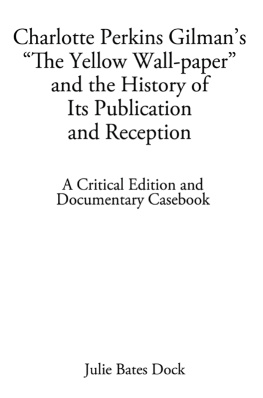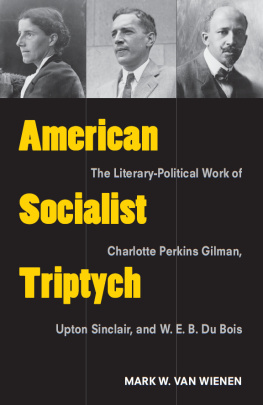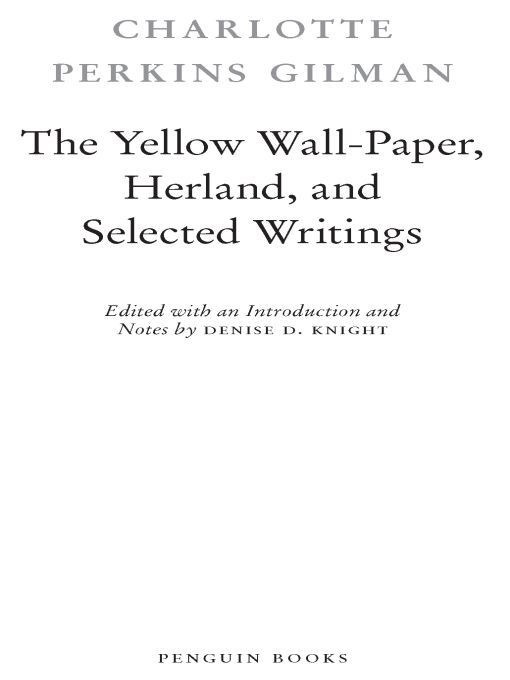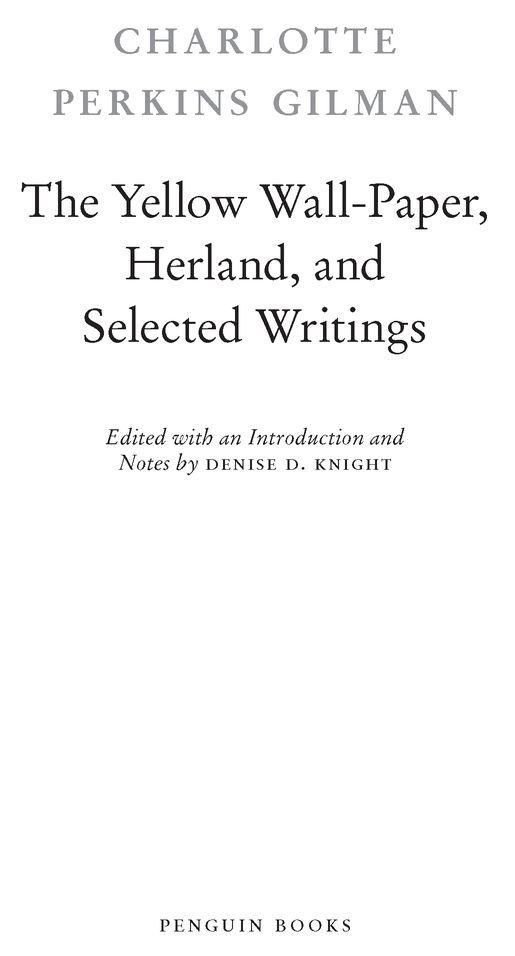Table of Contents
PENGUIN CLASSICS
THE YELLOW WALL-PAPER, HERLAND, AND SELECTED WRITINGS
CHARLOTTE PERKINS GILMAN (1860-1935) was born in New England, a descendant of the prominent and influential Beecher family. Despite the affluence of her famous ancestors, she was born into poverty. Her father abandoned the family when she was a child, and she received just four years of formal education. At an early age she vowed never to marry, hoping instead to devote her life to public service. In 1882, however, at the age of twenty-one, she was introduced to Charles Walter Stetson (1858-1911), a handsome Providence, Rhode Island, artist, and the two were married in 1884. Charlotte Stetson became pregnant almost immediately after their marriage, gave birth to a daughter, and sank into a deep depression that lasted for several years. She eventually entered a sanitarium in Philadelphia to undergo the rest cure, a controversial treatment for nervous prostration, which forbade any type of physical activity or intellectual stimulation. After a month, she returned to her husband and child and subsequently suffered a nervous breakdown. In 1888, she left Stetson and moved with her daughter to California, where her recovery was swift. In the early 1890s, she began a career in writing and lecturing, and in 1892, she published the now-famous story The Yellow Wall-Paper. A volume of poems, In This Our World, followed a year later. In 1894, she relinquished custody of her young daughter to her ex-husband and endured public condemnation for her actions. In 1898, her most famous nonfiction book, Women and Economics, was published. With its publication, and its subsequent translation into seven languages, Gilman earned international acclaim. In 1900, she married her first cousin, George Houghton Gilman. Over the next thirty-five years, she wrote and published hundreds of stories and poems and more than a dozen books, including Concerning Children (1900), The Home: Its Work and Influence (1903), Human Work (1904), The Man Made World; Or, Our Androcentric Culture (1911), Moving the Mountain (1911), Herland (1915), With Her in Ourland (1916), His Religion and Hers: A Study of the Faith of Our Fathers and the Work of Our Mothers (1923), and The Living of Charlotte Perkins Gilman: An Autobiography (1935). From 1909 to 1916 she singlehandedly wrote, edited, and published her own magazine, The Forerunner, in which the utopian romance Herland first appeared. In 1932, Gilman learned that she had inoperable breast cancer. Three years later, at the age of seventy-five, she committed suicide, intending her death to demonstrate her advocacy of euthanasia. In 1993, Gilman was named in a poll commissioned by the Siena Research Institute as the sixth most influential woman of the twentieth century. In 1994, she was inducted posthumously into the National Womens Hall of Fame in Seneca Falls, New York.
DENISE D. KNIGHT is professor of English at the State University of New York at Cortland, where she specializes in nineteenth-century American Literature. She is author of Charlotte Perkins Gilman: A Study of the Short Fiction and editor of The Later Poetry of Charlotte Perkins Gilman, The Diaries of Charlotte Perkins Gilman, The Abridged Diaries of Charlotte Perkins Gilman, The Yellow Wall-Paper and Selected Stories of Charlotte Perkins Gilman, and Nineteenth-Century American Women Writers: A Bio-Bibliographical Critical Sourcebook. She is also the author of numerous articles, essays, and reviews on nineteenth-century American writers.
ACKNOWLEDGMENTS
I wish to express my appreciation to Kristine Puopolo, my editor at Penguin Books, for her commitment to this project and for her guidance and thoughtful suggestions. I am also grateful to Gretchen M. Gogan in the interlibrary loan department at the State University of New York at Cortland for cheerfully and promptly responding to my requests for assistance. Gary Scharnhorst deserves recognition for his early work on Gilman and particularly for compiling Charlotte Perkins Gilman: A Bibliography (1985), an indispensable resource for Gilman scholars. Most of all, I thank my husband, Michael K. Barylski, for his ongoing love, support, encouragement, and interest in my work on Gilman.
INTRODUCTION
Near the end of her autobiography, Charlotte Perkins Gilman (1860-1935) sardonically remarks that This is the womans century, the first chance for the mother of the world to rise to her full place, ... to remake humanity, to rebuild the suffering worldand the world waits while she powders her nose. Frustrated both by women who transformed themselves into sex objects for the pleasure of men and by societys gender-based double standard, Gilman created a fictional utopia, Herland (1915), where such frivolous items as face powder would be obsolete. Indeed, not only is Herland devoid of feminine vanity of any kind, its all-female inhabitants have created a peaceful, progressive, environmentally conscious country from which men have been absent for two thousand years. Rather than suffering deprivation, the women have thrived. Herland depicts a healthy, alternative view of women and demonstrates a degree of social reform that Gilman, caught in the conventional trappings of the turn-of-the-century patriarchal society, could envision only in her imagination.
Born Charlotte Anna Perkins in Hartford, Connecticut, on July 3, 1860, Gilman was the great-niece of Harriet Beecher Stowe, author of Uncle Toms Cabin (1852), and Henry Ward Beecher, the renowned minister. Despite her famous ancestry (her great-grandfather was the distinguished theologian Lyman Beecher), Gilman lived a troubled childhood. After her father abandoned the family, her mother, a part-time day-school teacher, was left to raise two children on her own. With only meager earnings, it was a precarious existence. During her adolescence, Gilman became a passionate rebel, defiantly rejecting the conventional roles deemed appropriate for late-nineteenth-century women. At the age of eighteen, she entered the Rhode Island School of Design, where she studied drawing and painting. By the time she was twenty she had decided to devote her life to public service. Although she had vowed never to marry, in January 1882 she met Rhode Island artist Charles Walter Stetson, who proposed marriage just two-and-a-half weeks later. Fearing that marriage would compromise her desire to work, Gilman quickly declined. In a letter to Stetson, Gilman tried to express her reservations: As much as I love you I love WORK better, & I cannot make the two compatible.... I am meant to be useful & strong, to help many and do my share in the worlds work, but not to be loved. Stetson persisted with marriage proposals for nearly two years, however, and despite serious misgivings on Gilmans part, they were married on May 2, 1884.
Within weeks after the wedding Gilman became pregnant and sank into a deep depression. Her daughter, Katharine Beecher Stetson, was born on March 23, 1885. Gilman recalled in her autobiography both the severity of her distress and the self-blame that she suffered:
Absolute incapacity. Absolute misery.... Prominent among the tumbling suggestions of a suffering brain was the thought, You did it yourself! You had health and strength and hope and glorious work before youand you threw it all away. You were called to serve humanity, and you cannot serve yourself. No good as a wife, no good as a mother, no good at anything. And you did it yourself! ... I would hold [the baby] close, and instead of love and happiness, feel only pain.... Nothing was more utterly bitter than this, that even motherhood brought no joy.







